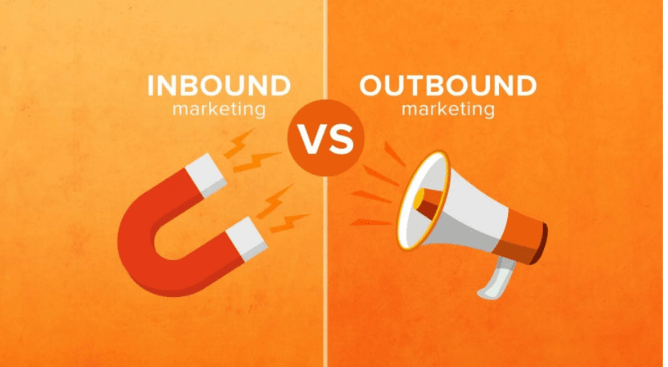At Digital Doctor, we believe that blogging on a regular basis will benefit your business. Blogging adds content to your website and promotes your brand.
In our first of a series of posts on the whys and wherefores of blogging, we’re taking a look at the differences between inbound and outbound marketing strategies. By understanding the differences you can start to focus on which strategy is going to work for you and your business. Hopefully, we’re giving you something to ponder upon - and you’ll take action to incorporate blogging into your marketing plan.
Our second blog in the series covers 'What are the business benefits of blogging' and if you already know what they are, read up on 'How to write a blog brilliantly' which ensures you follow best practice.
Let’s get back to some basics before we hone in on the detail.
Back in prehistoric times, before the World Wide Web, businesses would promote themselves via local and national newspaper ads, magazines, radio and TV advertising and something called the Yellow Pages. Here at Digital Doctor we’re old enough to remember the tome and it wasn’t just because of its merits as superior rabbit hutch insulation.
Back to 2020 and marketing strategies can reach audiences in a variety of ways.
Outbound marketing
Outbound marketing is the more traditional, ‘salesy’ method - you actively reach out to your customers rather than waiting for them to come to you. You can push an ad whether the audience wants it or not but you do run the risk of turning them away from your site if advertising is excessive. (At this point I will share my frustration when watching anything on the ITV hub when the first thing you’ll see is an advert.)
Outbound strategies work if you want to reach a specific audience with a quick return from your efforts. Outbound can produce high quality leads but it’s all about the attention and not about the value i.e. there’s very little in the way of engagement between you and the customer at this point.
Email marketing
Email marketing is a form of outbound marketing and is another way of generating leads for your business. However, there’s some initial work to do to establish an email list. Generally you can do this by creating a ‘lead magnet’ that will invite potential customers to sign up to something.
Examples of magnets could be signing up for a webinar, a video, a pdf, a blog post, a survey, free trials, even a quiz. Ask for a name and email address (nothing more as this will put off your potential leads). Just like a blog, you’ll need to research what you think will be relevant to your potential customers so you can entice them with your offer.
Buying email lists is a no-no, as is compiling a list from people you’ve engaged with at various conferences (but you have so many business cards - that must be a good thing we hear you ask). Generating emails to people who haven’t opted in to your email list or given their express permission to be contacted will be treated as spam.
With social media platforms enabling your followers to be notified when you’re launching a new blog, we feel email marketing, whilst effective for larger businesses, needs more time invested. If you need to create a blog to ask people to download it (so you get their email details) you might as well cut out the middle human so to speak and go straight to blog mode. This is where LinkedIn comes into its own - network and connect, connect and network...
Stating the obvious, OB strategies are more expensive (both in terms of money and time). The downside to a paid ad is that you haven’t created any rich, informative content that will remain on your website for the future (referred to as evergreen). You’re in the ‘here and now’ and grab ‘em quick mode. Whilst you’ve invested in the ad and hope you’ll generate leads from it, it’s not likely to yield interest in the future.
Inbound marketing
Inbound marketing is all about investing time and energy into creating great content for your site. This is a softer approach and as a consequence, we argue that your sales leads will be of a higher quality. This strategy is focused on the value you’re offering and not the attention (although a good blog will need to hold attention for at least 37 seconds!).
A brilliant blog will have done its research and looked at what its audience needs to know about. The message must be specific, useful and above all, relevant. Your blog is looking to engage with your customer base, establish trust and aim to provide educational and insightful content.
Inbound marketing will work for businesses big and small, give you a greater ROI and encourage a loyal fan base. Your audience will come back to you each time you blog providing you are consistently putting content out there for them to read. Great content is the long game though and building up your following will take time.
Blog promotion
IB strategies need to be promoted; a blog on its own isn’t going to get you very far. Look to promote your new blog via social media platforms, giving you greater reach as your followers then share with their peers. Ensure you do a shout-out on Facebook and LinkedIn (87% of marketers use this combination (CMI & Marketing Profs)) and think about a tweet or 2 while you’re at it.
Do the analytics
And finally (for the moment) it’s worth doing your homework after the event. One reason given by businesses who abandon a blog marketing strategy is that they haven’t analysed the web stats and assessed a blog’s impact. These are just a few questions businesses should be investigating:
- What happens to the traffic who visits my blog?
- Where do they go next?
- Should I be thinking about adding a Call To Action within my blog (for example, an email form could potentially bring your next customer to you).
Look out for our next blog which gives you an overview of the business benefits of blogging and how you can present the data to your business partners to get the strategy up and running. We’ve done our own research and read up a bit so you don’t have to.
If you’re interested in getting more information from us at Digital Doctor and find out how we can help you run blog campaigns using the Rocketspark platform then contact sarah@digital-doctor.co.uk.




